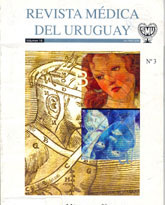Ciclospora cayetanensis en Uruguay
Agente de diarrea del viajero, adquirida en el exterior
Resumen
Cyclospora cayetanensis (Ortega, Gilman & Sterling, 1994), es el agente emergente de la ciclosporiasis, nueva afección diarreica descrita como aguda y autolimitada, de dos a seis semanas de duración en inmunocompetentes y diarrea crónica intermitente en pacientes con sida. Esta afección y su agente han sido notificados recientemente en Uruguay, afectando a viajeros provenientes de áreas reconocidamente endémicas para este nuevo protozoario coccidio entérico. En la presente comunicación se examina la totalidad de la casuística conocida en el país, y se concluye que C. cayetanensis es en Uruguay un agente de diarrea del viajero, sin registro de ocurrencia autóctona hasta la fecha.
Citas
2) Kovanda JS. Traveler's diarrhea: patogenesis and management. Rev Med Liege 2000; 55(6): 492-99.
3) Olsen W. Parasitología animal. 2a.ed. Barcelona: Argos, 1990.
4) Ortega Y, Sterling C, Gilman R, Cama V, Díaz F. Cyclos-pora species a new protozoan pathogen of humans. N Engl J Med 1993; 328(18): 1308.
5) Ortega Y, Gilman R, Sterling C. A new coccidian parasite (Apicomplexa: Eimeriidae) from humans. J Parasitology 1994; 80(4): 625.
6) Salvatella R, Eirale C, Sundberg F. Primera notificación de Cyclospora cayetanensis en Uruguay, a partir de un caso de diarrea del viajero adquirido en el exterior. Rev Urug Pat Clínica 2000; 32: 9-12.
7) Soave R, Johnson W. Cyclospora: conquest of an emerging pathogen. Lancet 1995; 345(8951): 667.
8) Clarke S, McIntyre M. Human infection with Cyclospora. J Infect Dis 1994; 29(1): 112.
9) Wittner M, Tanowitz H, Weiss L. Parasitic infections in AIDS patients. Infect Dis Clin North Am 1993; 7(3): 569.
10) Mannheimer S, Soave R. Protozoal infections in patients with AIDS. Infect Dis Clin North Am 1994; 8(2): 483.
11) Centers for Disease Control and Prevention (CDC), Division of Parasitic Disease. Identification and Diagnosis of parasites of public health concern. Atlanta: CDC, 2000.
12) Centers for Disease Control and Prevention (CDC), Division of Parasitic Disease. Cyclospora infection. Information for health care providers. Atlanta: CDC, 1999.
13) Herwaldt B, Ackers M, CWG. An outbreak in 1996 of cyclosporiasis associated with imported raspberries. N Engl J Med 1997; 336(22): 1548-56.
14) Centers for Disease Control and Prevention (CDC): Update. Outbreaks of Cyclospora cayetanensis infections. United States and Canada, 1996. MMWR 1996; 45(28): 611.
15) Rabold J, Hoge C, Shlim D, Kefford C, Rajah R, Echeverría P. Cyclospora outbreak associated with chlorinated drinking water. Lancet 1994; 344(8933): 1360.
16) rganización Panamericana de la Salud. El control de las enfermedades transmisibles en el hombre. 17ª ed. Washington: OPS, 2001: 98-9.
17) Instituto C. Malbrán. Coproparasitología. Buenos Aires: Inst C Malbrán: 1993.
18) Eberhard MD. Laboratory diagnosis of Cyclospora infections. Arch Pathol Lab Med 1997; 121: 792-7.
19) Ritchie LS. An Ether Sedimentation Technique for rutine Stool Examination. Bull US Army Med Dept 1948; 8: 326.
20) Salvatella R, Eirale C. Examen coproparasitario. Metodología y empleo. Revisión técnico metodológica Rev Med Uruguay 1996; 12(3): 215-25.
21) Bonifacino R. Diagnóstico de Cryptosporidium sp. Por la técnica de Ziehl Neelsen modificada. Rev Soc Urug Parasitol 1987; 1(1): 7-14.
22) Orlandi PA, Lampel KA. Extraction-Free, Filter-Based Template Preparation for Rapid and Sensitive PCR Detectin of Pathogenic Parasitic Protozoa. J Clin Microbiol 2000; 38(6): 2271-7.
23) Sterling C, Ortega Y. Cyclospora: an enigma worth unraveling. Emerg Infect Dis 1999; 5(1): 1-8.














